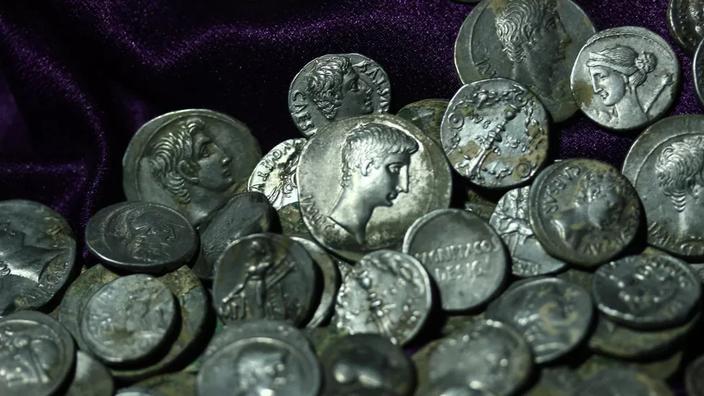It is a discovery as precious as it is fortuitous.
Buried near the river that once ran through the ancient city of Aizanoi in Western Anatolia, a common ceramic jug held 651 BC silver coins, Roman denarii and Hellenistic drachmas.
AD;
a monetary treasury dating from the very end of the Roman Republic to the early days of the Empire.
Read also: Found in Hampshire, an 11th-century Chinese currency opens up new avenues for medieval trade
Discovered in September 2019 by Turkish archaeologists, near the current city of Çavdarhisar, in the province of Kütahya, the treasure is composed of 439 Roman denarii and 212 cistophoric drachmas, typical of Pergamon coinage.
All the coins are dated from 75 to 4 BC.
J.-C .. The Roman pieces include portraits of Caesar, Augustus, Brutus and still Marc Antoine.
Many minted in the south of the Italian peninsula, several of these coins are adorned with references to Aeneas' gesture.
Hellenistic cistophoric coins are recognizable by their Dionysian decoration of snakes, cists and, often, thyrsus or flowers.
They were put into circulation by the Hellenistic kingdom of Pergamon around the beginning of the 2nd century BC.
AD, although a debate has long opposed researchers on the beginnings of this coinage.
However, it continued to be minted and used in the eastern Mediterranean in Roman times, after the annexation of the Attalid kingdom of Pergamon in 133 BC.
J.-C .. "
New Dionsysos
", Marc Antoine thus had cistophores struck in his image at the time of the second triumvirate (43 to 33 BC).
Read also: A 12th-century princely treasure, consisting of 6,500 pieces, discovered in a Polish cornfield
For archaeologist Elif Özer of Pamukkale University in Denizli, Aizanoi's monetary treasury may have been buried by a Roman officer.
“
It was an extremely interesting discovery.
It is likely that a high ranking soldier came to Aizanoi, and that he must have buried these pieces here for some reason that we do not yet know
, ”he proposed in a statement to
Live Science
.
Originally a Hellenistic Bithynian city, Aizanoi was incorporated into the kingdom of Pergamon in 184 BC.
AD. Renowned for its large sanctuary dedicated to Zeus, the city had been under Roman administration for more than a century when the treasure was buried, around 4 BC.
The hundred or so ancient coins were sent to the Museum of Anatolian Civilizations in Ankara where they should soon be exhibited.

